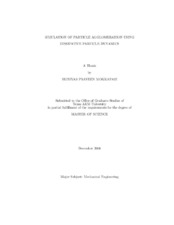| dc.description.abstract | Attachment of particles to one another due to action of certain inter-particle
forces is called as particle agglomeration. It has applications ranging from efficient
capture of ultra-fine particles generated in coal-burning boilers to effective discharge
of aerosol sprays. Aerosol sprays have their application in asthma relievers, coatings,
cleaning agents, air fresheners, personal care products and insecticides. There
are several factors that cause particle agglomeration and based on the application,
agglomeration or de-agglomeration is desired. These various factors associated with
agglomeration include van derWaals forces, capillary forces, electrostatic double-layer
forces, effects of turbulence, gravity and brownian motion. It is therefore essential
to understand the underlying agglomeration mechanisms involved. It is difficult to
perform experiments to quantify certain effects of the inter-particle forces and hence
we turn to numerical simulations as an alternative. Simulations can be performed
using the various numerical simulation techniques such as molecular dynamics, discrete
element method, dissipative particle dynamics or other probabilistic simulation
techniques.
The main objective of this thesis is to study the geometric characteristics of particle
agglomerates using dissipative particle dynamics. In this thesis, agglomeration
is simulated using the features of dissipative particle dynamics as the simulation technique.
Forces of attraction from the literature are used to modify the form of the
conservative force. Agglomeration is simulated and the characteristics of the result ing agglomerates are quantified. Simulations were performed on a sizeable number
of particles and we observe agglomeration behavior. A study of the agglomerates
resulting from the different types of attractive forces is performed to characterize
them methodically. Also as a part of this thesis, a novel, dynamic particle simulation
technique was developed by interfacing MATLAB and our computational C program. | en |


